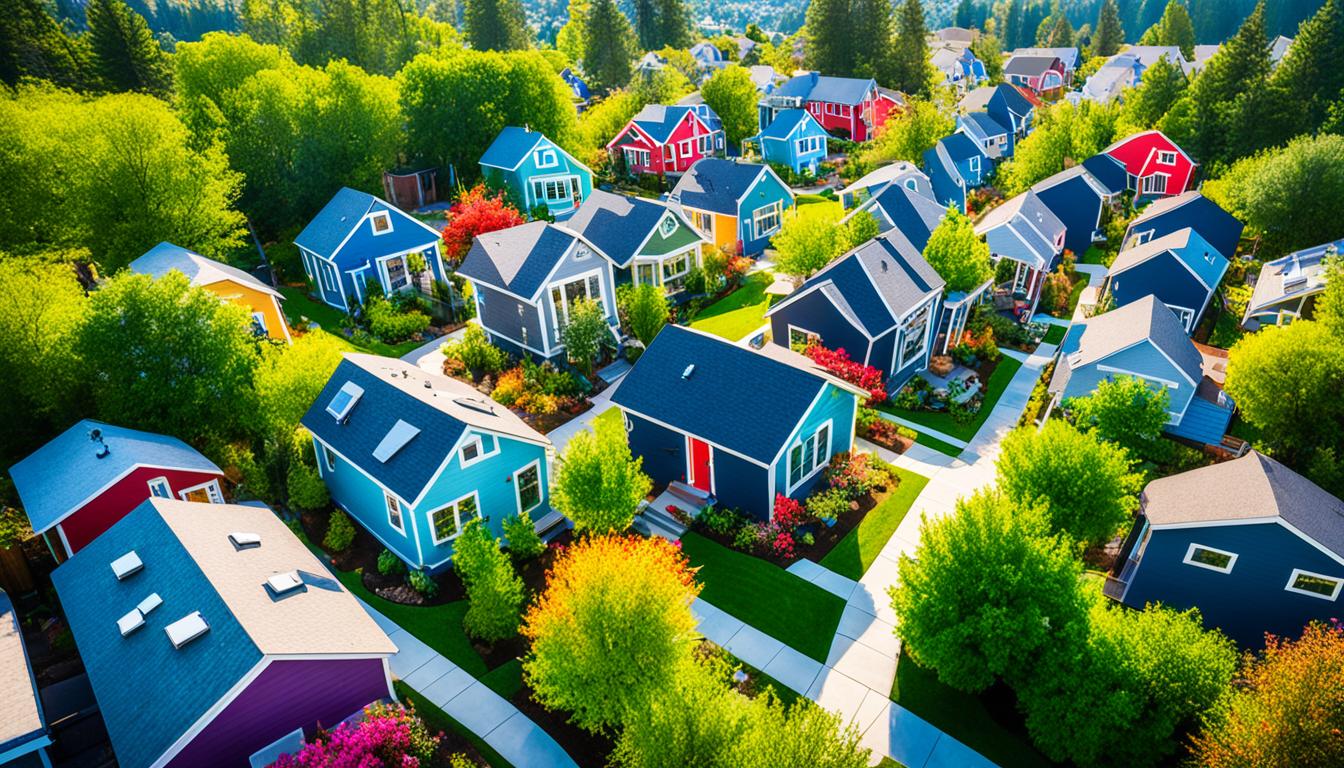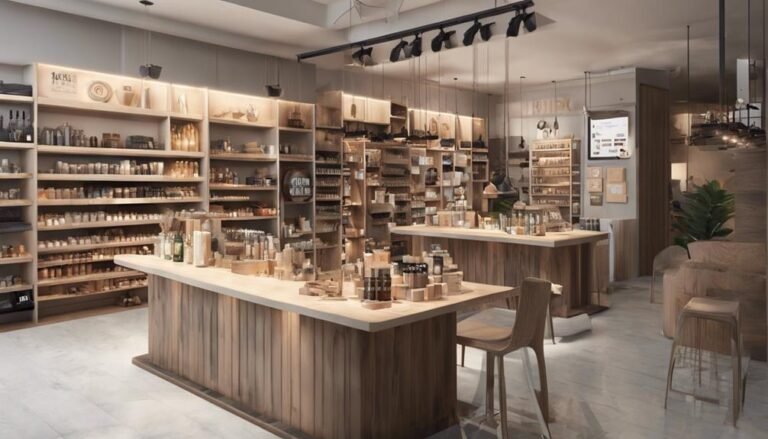Designing, building, and living in tiny homes or converted spaces.
Have you ever thought about living in a tiny home with everything you need in just a few hundred square feet? Tiny homes and alternative living spaces are more than just a way to save space. They’re about living sustainably and simply. They offer financial freedom and are good for the planet.
Starting this journey means careful planning and design. It’s about making a life that’s both efficient and sustainable. Tiny homes let you live off the grid in a way that’s innovative and eco-friendly.
This guide will show you how to make the most of a small space. It’s perfect for those who want to save money on bills or live more sustainably. You’ll learn about the benefits of minimalist living solutions.
Looking at the experiences of those who live in tiny homes can teach us a lot. It’s important to plan your space well and design it to fit your life. We’ll explore strategies like the “Post-it exercise” to make sure your space is both beautiful and functional.
Key Takeaways
- Financial freedom is a big reason people choose tiny homes, saving a lot on utilities.
- Good insulation is key for keeping energy use low and living comfortably.
- Solar panels and batteries provide reliable, eco-friendly power in off-grid homes.
- Composting toilets and collecting rainwater help save water in tiny homes.
- Smart design and furniture choices make the most of a small living space.
Start your journey to a simpler life by exploring our guide. We’ll cover why tiny homes are appealing and how to design the perfect space for you.
Understanding the Appeal of Tiny Homes and Alternative Living Spaces
People are turning to tiny homes for financial freedom, a smaller environmental impact, and a simpler life. The Small House Movement shows that downsizing living spaces is becoming popular. It’s not just about saving space; it’s a choice for a simpler way of living.
Why People Are Choosing Tiny Homes
Tiny homes are cheaper to build or buy than traditional houses. This makes them more affordable and can lead to homeownership faster. They also use less energy, making them better for the planet. Many tiny homes use solar panels to get clean energy.
Living in a tiny home means owning less and wasting less. This appeals to those wanting to live sustainably. Investors like tiny homes for their low cost and high demand in affordable housing.
The Rise of the Small House Movement
The Small House Movement is growing fast as people look for efficient living spaces. It includes tiny houses on wheels, cabin-style homes, and modular homes. Cities are working with tiny-home startups to offer homes under 400 square feet to tackle housing shortages. Tiny house communities offer shared spaces like laundry and gardens, making this lifestyle more appealing.
| Aspect | Tiny Home | Traditional Home |
|---|---|---|
| Average Size | 65 to 700 sq ft | 2,600 sq ft |
| Construction Cost | Low | High |
| Environmental Impact | Low | High |
| Utility Costs | Fraction of traditional home | High |
| Building Time | Short | Long |
Minimalist Housing: A Lifestyle Choice
Minimalist housing is now a lifestyle choice for many. Tiny homes offer simplicity and efficiency. They encourage living with fewer belongings, making for a clutter-free life. Despite their size, tiny homes can feel cozy and intimate.
However, tiny homes have challenges like limited storage and privacy. Legal issues can also affect owning a tiny home. Yet, the Small House Movement is growing, showing more interest in minimalist and sustainable living. Options like Micro Apartments and modular homes are becoming more popular.
Planning Your Tiny Home: Determining Your Needs
When *planning a tiny home*, every inch matters. You need to plan carefully to make the most of your space. This ensures your tiny home fits your lifestyle perfectly.
The Importance of Accurate Planning
Good planning helps with *space limitations* and missing amenities. Tiny houses are usually 100 to 400 square feet. Making the most of this space is key. Plus, tiny houses use only about 7% of the energy of traditional homes.
The Post-It Note Exercise
The Post-It Note exercise is great for *planning a tiny home*. It helps you see how you’ll use the space. Write down how often and long you do activities in each area. This helps you use space well by focusing on what’s important.
Creating a Functional Layout
A good layout is crucial for *planning a tiny home*. Use the Post-It Note method to design your space. For example, a 12×24 tiny house can fit up to four people. A 14×28 model can fit up to six.
| Tiny House Size | Capacity | Attributes |
|---|---|---|
| 100-150 sq ft | 1 person | Ideal for efficient living |
| 200-300 sq ft | Couples or small families | Flexibility in functionality |
| 12×24 | Up to 4 people | Comfortable accommodation |
| 14×28 | Up to 6 people | Spacious and versatile |
In conclusion, good *planning for a tiny home* means every part of your home has a purpose. It combines convenience, efficiency, and comfort.
Designing Your Tiny Home: Innovative and Practical Tips
Making the most of a small space is key in tiny home designs. Using smart strategies for space and off-grid living can turn a small area into a cozy, green home. Here are some tips to make your tiny home work well.
Space-Saving Techniques
Getting the most out of your tiny home’s space is essential. Use built-in storage like under-stair cabinets or lofted beds with storage. Adding vertical space with shelves and fold-out furniture helps keep things tidy. Designers often mix different uses in one area, like a dining table that doubles as a workspace.
Multipurpose Furniture Ideas
Choosing furniture that does more than one thing is crucial in tiny homes. Think about Murphy beds, couches that turn into guest beds, and tables with storage. Ottomans and benches with secret compartments also help keep things organized and make the most of your space.
Off-Grid Living Preparations
As off-grid living becomes more popular, adding green features to your tiny home is important. Use top-notch insulation, solar panels, and wind turbines to be energy independent. LED lights and smart energy systems help save power. Water-saving systems like low-flow fixtures and greywater systems also help.
Using Structural Insulated Panels (SIPs) makes your home well-insulated and quick to build. Keeping your home airtight with proper sealing helps control the temperature and air quality. This is crucial for comfort in off-grid homes.
Luxury tiny home builders like Tru Form Tiny offer designs that are both sustainable and innovative. They cater to those wanting a minimalist lifestyle.
| Feature | Benefit |
|---|---|
| Built-In Storage | Maximizes space utilization |
| Multipurpose Furniture | Enhances functionality |
| High-Quality Insulation | Improves energy efficiency |
| Solar Panels | Promotes off-grid living |
| LED Lighting | Reduces energy consumption |
By using these tips for space and preparing for off-grid living, you can enjoy a tiny home that’s both sustainable and efficient.
Building a Tiny Home: Key Considerations
Building tiny homes means picking the right materials is key. Choosing sustainable materials helps the planet and saves money over time. These homes, often called Accessory Dwelling Units (ADUs), are small, measuring from 150 to 430 square feet.
The size of a tiny home affects many things, like utility connections and property value. It’s important to follow local building rules and zoning laws, especially for ADUs. In California, ADUs can be up to 1,200 square feet, depending on where you live.
Dealing with moisture and insulation is crucial in DIY tiny home building. Using quality insulation keeps your home comfy all year. It’s vital for making the most of limited space.
Getting ready for utilities like power, water, and waste management is a big step. Permanent ADUs can really boost your property’s value. Knowing the laws and zoning rules helps avoid problems like parking fines.
Living in a tiny home can save money on upkeep and bills. It’s a good choice for young people and retirees. Adding things like solar panels and insulation makes tiny homes green and cozy.
Source Links
- Innovative Off-Grid Tiny Homes: Design and Efficiency Guide – United Tiny Homes
- Off-Grid Tiny House Guide – The Tiny Life
- Living in a Tiny House With Basement: Everything You Need to Know
- The Future of Tiny Houses: Revolutionizing Sustainable Living – United Tiny Homes
- Exploring the Tiny Homes Movement
- Tiny Homes and Alternative Properties: Essential CPA Knowledge for Client Guidance
- Why Are Container Homes in Las Vegas Becoming Popular?
- How to Live Comfortably in a Tiny House: Exploring the Different Sizes Available – United Tiny Homes
- Universal Storage Containers, Wholesale Distributor of Portable Storage Containers
- Energy Efficient Tiny Homes: Design Strategies and Benefits – Terra Home Performance
- Affordable Tiny Homes: Sustainable Materials for Simple and Practical Solutions — BillionBricks
- The Future of the Tiny House Movement & Sustainable Living
- Tiny Home vs. ADU: Differences Explained in Small Housing
- Why Buying a Tiny Home Is Perfect for My Tiny Budget
- Introduction to Backyard Tiny Homes







